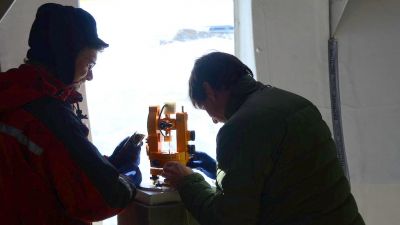
GEOMAG: A New Magnetic Observatory in East Antarctica near Utsteinen
The GEOMAG (GEOMAGnetic Observatory) research project aims to conduct long-term observations of Earth’s geomagnetic field at the Princess Elizabeth Antarctic research station.
Why observe Earth’s geomagnetic field?
In order to describe and understand current and future evolution of the planet’s geomagnetic field, it is important to observe how the field moves and changes over time. Geomagnetic field observations are particularly important to make in the Polar Regions, where good geomagnetic observatories are few and unevenly spaced. Geomagnetic field observations at higher latitudes are crucial for Solid Earth modelling and to study space weather. Having accurate geomagnetic field observations can also come in handy when navigating the vast, remote areas of Antarctica in the event your GPS fails.
State-of-the-art instrumentation
Monitoring the geomagnetic field during the winter months in Antarctica is particularly difficult, given that observations of the field have, until now, required a researcher to be on-site to take regular measurements of the geomagnetic field. As the majority of research stations in Antarctica do not have overwintering teams, this creates a problem for observing the Earth’s Geomagnetic field in Antarctica during the austral winter.
The GEOMAG project plans to solve this problem through the use of new state-of-the-art instruments, some of which have been designed at the Royal Meteorological Institute of Belgium’s Centre de Physique du Globe in Dourbes.
One of the instruments that will be used at this new observatory is a nonmagnetic theodolite known as Autodif, which can take automated absolute measurements of Earth’s geomagnetic field, as well as create a time series of the geomagnetic field’s position in three dimensions. Since no human operator is needed, measurements of the Earth’s geomagnetic field can be taken throughout the entire polar winter.
The observatory will also house a proton Overhauser magnetometer and a triaxial variometer, sampling up to 10 times per second. Data from the new observatory will also contribute to the European Space Agency’s SWARM satellite programme, a constellation of satellites that observes the Earth’s geomagnetic field from space. The data collected by the instruments used in the GEOMAG project will abide by the standards laid out by INTERMAGNET.
Construction over three seasons
All instruments will be installed in a specially designed nonmagnetic shelter 600 metres away from the Princess Elisabeth Antarctic station, at the foot of Utsteinen Ridge. Keeping this distance will avoid magnetic interference from the activity at the station. A survey to find an idea location for the shelter was conducted during the 2013-14 season. Construction of the shelter housing the instruments was successfully completed during the 2014-15 season along with the deployment of two instruments. A third instrument is scheduled to be installed inside the shelter during the 2015-16 season.
The GEOMAG project was designed by Jean Rasson from the Royal Meteorological Institute of Belgium. Alexandre Gonsette and Stephan Bracke are the GEOMAG project’s principal investigators, and are in charge of designing and setting up the observatory and instruments to be installed in Antarctica.
Picture: Station engineer Johnny Gaelens helps Stephan Bracke from the Geophysical Center of Dourbes take magnetic field measurements. - © International Polar Foundation / Jean Rasson
